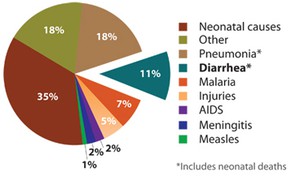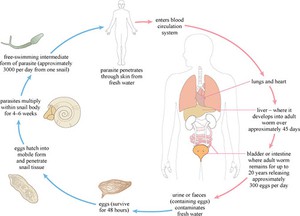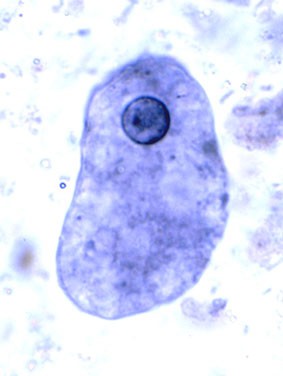Common diseases associated with water in Ethiopia
The government of Ethiopia is taking steps to improve the quality of water supply in urban areas of the country, but many people suffer from communicable diseases associated with water. Data from Harari Region are used here as an example. Table 2.2 shows the diseases that were most prevalent in Harari Region in 2013/2014.
Table 2.2 The prevalence of diseases associated with water in Harari Region in 2013/2014. (Harari Regional Health Bureau, 2014)
| Disease | Number of people affected |
| Diarrhoeal diseases (e.g. rotavirus infection, cholera) | 6345 |
| Malaria | 3861 |
| Infection by intestinal parasites | 462 |
| Trachoma | 432 |
| Amoebic dysentery | 365 |
The sections that follow describe these diseases in more detail.
Diarrhoeal diseases
Diarrhoea is a symptom of many waterborne diseases and is the cause of 11% of deaths among children aged under 5 across the world, with a reported total of 2195 deaths each day (Liu et al., 2012). The global major causes of death in children under 5 are shown in Figure 2.3.

Figure 2.3 Diarrhoea kills more children under 5 years of age across the world than malaria, measles and AIDS combined. (Liu et al., 2012)
Worldwide, 88% of diarrhoeal disease is attributable to unsafe water, poor hygiene and inadequate sanitation. In Ethiopia, 15% of all deaths are from diarrhoea, with the highest death rate among young children (World Life Expectancy, n.d.). Children, especially those under 5 years of age, are vulnerable to infection because they frequently put their unwashed fingers in their mouths.
One important example of a diarrhoeal disease is cholera. Cholera is an acute bacterial infection of the intestinal tract that produces watery diarrhoea. It is caused by the bacterium Vibrio cholerae (Figure 2.4) and causes severe loss of body fluids through diarrhoea, with the stool looking like rice-water. Without treatment, the disease can quickly lead to acute dehydration and death. Cholera is a worldwide problem, common in areas that lack basic sanitation. It can also be a problem in emergency situations (as you will learn in Study Session 14). It can be prevented by the provision of safe drinking water, effective sanitation and good hygiene behaviour, including food hygiene.

Figure 2.4 Vibrio cholerae (0.5–0.8 µm wide, and 1.4–2.6 µm long).
Malaria
Malaria is a parasitic disease transmitted by the female Anopheles mosquito and caused by the pathogenic protozoa Plasmodium. When a mosquito bites an infected individual it sucks up blood containing the parasite. If it then bites a healthy person, the protozoa is transferred into their blood and they can become ill. The mosquitoes breed in standing water such as swamps, lakes, pools and open channels dug for crop irrigation; even a puddle can provide enough water for mosquitoes to breed. Only the female mosquitoes take human blood, which is needed to develop their eggs. The most likely time for mosquitoes to bite is in the early evening or at night.
Can you think of ways to avoid being bitten by mosquitoes?
Wearing long-sleeved clothing and using insect repellents helps to keep people from being bitten. At night, mosquito nets (preferably impregnated with permethrin, which is toxic to mosquitoes) or various sprays or vapours can be used to keep them away.
Parasitic worm infections
People become infected with intestinal parasitic worms (helminths) through water or food that has been contaminated with faecal matter from an infected person. Infection occurs when these parasites get into the intestinal tract of a new host. Even though there are numerous parasites that infect humans, those most common in Ethiopia are the roundworms that cause ascariasis (Figure 2.5) and trichuriasis (Figure 2.6). Both of these diseases are spread through ingestion of contaminated food and water, and also poor hygiene behaviour. Children are more likely to be affected because their immune systems are not fully developed; they constitute important reservoirs of the infections.

Figure 2.5 Ascaris lumbricoides roundworm: these intestinal parasites can be very large – up to 35 cm long.

Figure 2.6 Trichuris trichiura roundworm: these parasites can reach 4 cm in length.
Schistosomiasis, also known as bilharzia, was mentioned earlier in this study session. It is also a disease caused by parasitic worms but in this case they do not get into the body from ingesting contaminated water or food. This is a water-based, not a waterborne disease. The Schistosoma parasitic worm enters the body by penetrating through the skin. It has a complicated life cycle and spends part of its life in a human body and part in a particular species of water snail, as shown in Figure 2.7.

Figure 2.7 Life cycle of the Schistosoma parasite.
The eggs of the worm are released into water bodies through the urine or faeces of an infected person and they then infect the snails, the intermediate host. Snails are more often found in slow-flowing or standing water where water plants are growing, rather than in rapidly flowing water. If the environmental conditions are not suitable for the snails, they will not survive and the disease cycle can be broken. In preventing water-based diseases like schistosomiasis, it is important to focus interventions on still waters of lakes and ponds and water channels used for irrigation, where vegetation is growing.
Trachoma
Trachoma is a bacterial eye infection that is made worse by poor hygiene due to lack of adequate water for washing. Repeated infections can lead to blindness if left untreated. Trachoma affects women and children more than adult men (WHO, 2002). It spreads easily from child to child or from child to mother, either directly by hand contact or indirectly on clothing, or by flies that land on the face of an infected child. A 2007 study found that 40% of Ethiopian children in the age group 1–9 years were suffering from active trachoma infection (Berhane et al., 2007). Good personal hygiene and encouraging children to wash their faces can significantly reduce incidence of the disease.
Amoebic dysentery
Amoebic dysentery, also called amoebiasis, is a disease caused by the protozoa Entamoeba histolytica (Figure 2.8). It is acquired by ingesting infectious cysts (a dormant form of the organism that helps it survive in unfavourable environments) through water or food items that are contaminated.

Figure 2.8 Entamoeba histolytica, up to 60 µm in size.